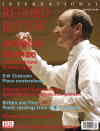Texte paru dans: / Appeared in:
*

International Record Review - (04/2012)
Pour
s'abonner / Subscription information
Glossa
GCD922509 (2CD)

8424562225091
Consultez toutes les évaluations recensées pour ce cd
~~~~ Reach all the evaluations located for this CD

This Schola Cantorum Hasiliensis recording, part of its renowned ‘Documenta’ series, was originally released in 1995 on Harmonia Mundi, which, in about 1990, had taken over from Deutsche Harmonia Mundi as the SCB’s record label. The ‘Documenta’ recordings presented often unusual and obscure repertoire from the Middle Ages to the Classical period (with occasional forays into the Romantic era) and the combined research and artistry of scholars and musicians (many of the latter both SCB alumni and scholars themselves). The SCB’s association with Harmonia Mundi ended around 2000. After a decade’s hiatus, during which it released only a few discs on various small labels, the SCB has found in Glossa another substantial Early Music label to publish its recordings. However, as this reissue shows, the SCB’s arrangement with Glossa is not limited to new recordings.
When this recording was first issued, a whole recording devoted to Francesco Cavalli’s religious music was even more of a rarity than it is today. This has been helped by the small size of Cavalli’s extant sacred oeuvre, the result of his reluctance to publish. He issued only two printed collections of church music, the Musiche Sacre of 1656 and the Vesperi a otto voci of 1675. Despite the great length of his activity at St Mark’s in Venice, almost continuously from his acceptance there as a boy soprano under Claudio Monteverdi to his death as its maestro di cappella in 1676, little of his sacred music survives outside the 1656 and 1675 collections. There are several currently available recordings of music from the latter book, but only one other recording of the Vespers for the Blessed Virgin Mary contained in the 1656 collection and that one, by the combined forces of the French vocal ensemble Akademia and instrumental group La Fenice, appeared only a year after Concerto Palatino ‘s.
Luckily for Cavalli aficionados, despite being well into the second decade since their original release, both recordings have lost none of their original allure and time has proved the soundness of the scholarship underpinning them. Although now presented in a modem tri-fold digipak, the documentation accompanying Concerto Palatino’s recording has not changed except for the addition of photographs of the dedication and ‘author’s instructions’ pages from the collection.
Both recordings feature single voices per part and all instrumental ensemble combining strings, cornetti and trombones. Yet, while the French recording is superb, Concerto Palatino’s account has the edge. First, the French sopranos seem slightly more operatic, shriller, less boyish and thus less ‘liturgical’ than Concerto Palatino ‘s lighter and marginally more agile Barbara Borden and Emily van Evera. Secondly, Concerto Palatino has no falsettists but relied on the super high tenor Rodrigo del Pozo and the two tenors Gerd Türk and Mark Padmore, then on top form, who move effortlessly into the alto range when required. Moreover, Concerto Palatino’s ensemble also features two ideal performers of early to mid-seventeenth century sacred music, both of them long-term Concerto Palatino regulars: the tenor Markus Brutscher, whose brilliant voice cuts through the ensemble textures like a beam of light, and the no less characterful dark bass of Harry van der Kamp.
Finally, Concerto Palatino adds an eight voice opening Versicle and response (Deus in adiutorium) by Nicolô Fontei to make up for Cavalli’s omission of one and also performs all six instrumental canzonas in the 1656 collection (La Fenice omitted the smallest and largest two, a 3 and a 12). These last are basically in the style of Giovanni Gabrieli, which by 1656 was quite old-fashioned, but updated harmonically and showing occasional glimpses of the idiomatic writing of Cavalli’s operatic ritornellos of the period. The cornettists Bruce Dickey and Doron Sherwin’s bright, sharply etched and muscular agility seems more apt for this particular work than La Fenice’s cornetti, which have a more liquid and less showy albeit no less assured agility. Concerto Palatino’s violinists, Enrico Gatti and Odile Edouard, as well as its trombones (eight of them to play the two largest canzonas a 10 and s 12) are also marginally more characterful than La Fenice’s. On the other hand, the French ensemble was considerably enriched by a bassoon and two theorbos and organs apiece next to Concerto Palatino’s sparer single violone, theorbo and organ.
This welcome re-release fully deserves an
‘outstanding’ accolade.
Fermer la fenêtre/Close window
Cliquez l'un ou l'autre
bouton pour découvrir bien d'autres critiques de CD
Click either button for many other reviews


